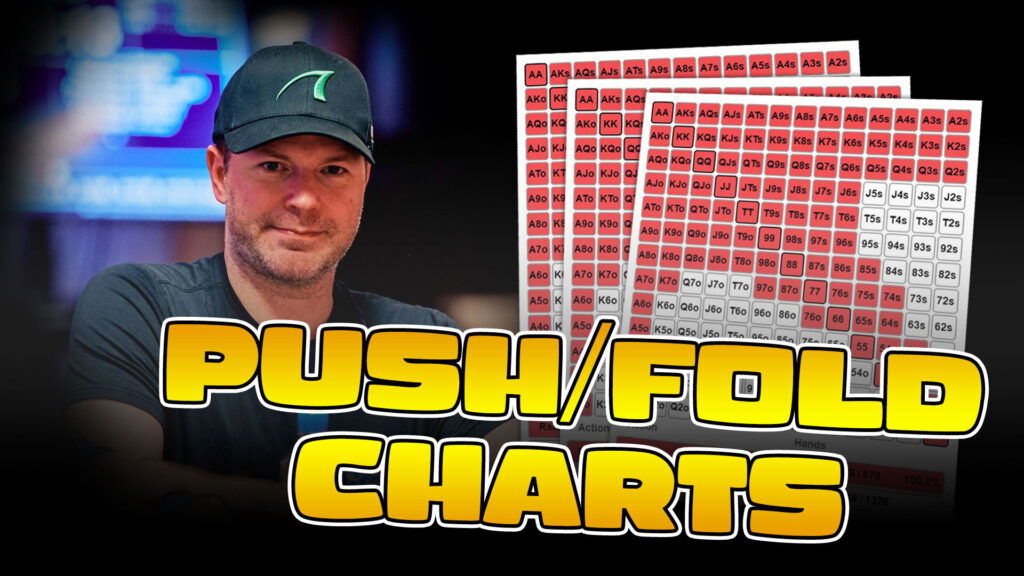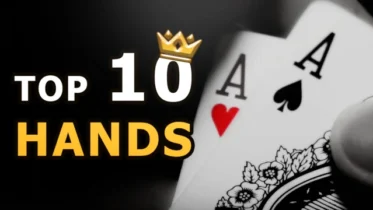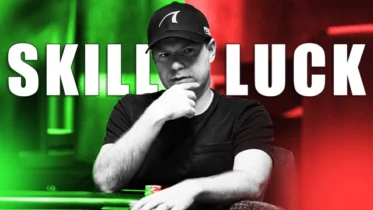It seems like everybody loves suited connectors. I guess they look pretty, the 8♥ snuggled up to its neighbor, the 7♥. Legendary poker vlogger Ethan “Rampage” Yau loves T♦-9♦ because it’s a natural in baccarat. Maybe it’s because it’s so fun to have your 6♣-5♣ beat pocket kings. I don’t understand all the reasons, but it’s undeniable that poker players love to play any two cards that are the same suit and one number apart.
Unfortunately, those hands can get you into trouble if they’re not managed correctly – here are three myths and three truths about suited connectors that will help you play these delicate hands properly.
Myth: Suited connectors are similar to small pocket pairs
Quite often, you see people dropping suited connectors into the same bucket with smaller pocket pairs: “Oh, I would play 8-7 suited or 6-6 in that spot.” There is a world of difference between those two hands. Let’s look at some numbers…
Your chance of flopping a set with a pocket pair is about the same as your chance of flopping a flush draw with two suited cards.
With a pocket pair such as 6♦-6♣, you’ll flop exactly a set 11.8% of the time. With two suited cards, such as 7♦-6♦, you’ll flop a draw to your flush 10.9% of the time. You will flop the whole flush a tiny 0.8% of the time.
Consider what happens after that. If you flop a set, you have a monster, and three streets of betting on which to capitalize on it and extract value from your opponents. Conversely, when you flop the flush draw, you are still a very long way from making your hand (you’re a 4:1 underdog to turn the flush). You will have to endure bets from your opponents and/or do some betting yourself as a semi-bluff.
Furthermore, the “big” hands you flop with suited connectors – two-pairs and trips with a weak kicker – are not the sorts of hands you want to play for stacks. Sets were born to play for all the money.
It’s just a lot better to start with a pocket pair than a suited connector, because the payoff, when it comes, is faster and bigger.
Myth: Suited connectors play well multi-way
You hear this statement tossed around a lot. It’s probably because people feel that with multiple players in the pot, you’re getting a better price to draw to your hand, and if you do hit a straight or a flush, it’s likely to be best, even in a multi-way pot.
There are three problems with this logic:
- More players means more betting. As we discussed above, it’s rare enough to flop a draw with a suited connector. Any time you can get free cards to draw, it’s a big win. But with two or more opponents, the chance of getting free cards goes down, and you are investing more in a fundamentally long-shot proposition.
- You win less when you make your hand. Yes, there are more potential “customers.” However, they also see that the pot is multi-way. When the draw arrives and you don’t worry, everybody else will be concerned about you. While you will frequently have the best hand, if giant piles of money go in when the flush card arrives, your 8-high flush may well be dead.
- Harder to win with a semi-bluff. We’ll get to this in more detail shortly, but your goal with your draws is to win the pot without actually hitting the draw. It’s much harder to bluff your way out of a multi-way pot than persuade just one player to fold.
My friend and teacher Andrew Brokos puts it like this: “All hands perform worse multi-way; suited connectors perform ‘less worse.’” Faint praise indeed.
Myth: If you miss the flop, you should fold
Many players play a “fit or fold” strategy with suited connectors. They plan to flop a four-card draw of some sort, or maybe a miracle two-pair or trips, and then proceed. If they don’t, they simply fold.
However, a lot of suited connectors’ equity involves seeing a turn card when you’ve flopped some backdoor opportunities. Suppose you’re playing $2/5 no-limit hold’em, the lo-jack opens to $15, and it folds to you on the button. GTOWizard gives (small) partial preflop calls with suited connectors all the way down to 5-4 suited. Let’s suppose you call with 8♠-7♠, and the blinds fold. The flop is 2♠-6♥-J♦, and our opponent bets $10 into the $35 pot. We have nothing – just backdoor dreams – so we fold, right?
Wrong. There are a ton of cards that breathe life into those backdoor dreams. Any 4 or ten gives us a gutshot straight draw. Any 5 or 9 gives us an open-end straight draw. And any spade gives us a flush draw. Only with no backdoor flush possibilities (87 suited in clubs) does the Machine (GTOWizard) fold. With our specific hand, it raises 44% of the time, and calls the rest.
We are literally raising 44% of the time with a hand that is 8-high, and can never be better than a pair of 8’s on the turn. What in the world is going on?
“What’s going on” will be revealed in the first “Truth” in our list. Get a fresh cup of coffee and listen closely…
Truth: Suited connectors are great bluffing hands
Consider the problem of trying to “get there” with a suited connector that has flopped a draw.
A four-card flush is a 4:1 underdog to complete on the next card. If you simply call a bet with a flush draw, you must believe you will win at least four times the amount of that call, either immediately or with subsequent bets. Even a 12-out draw (7♦-6♦ on a 3♦-4♠-Q♦ flop) is nearly a 3:1 underdog to turn a straight or a flush.
You might get reasonably close to the correct odds on the flop, taking into account subsequent bets. However, those opportunities usually evaporate on the turn, when bet sizes increase, and your implied odds – the chance to make more money once you’ve hit your hand – decrease.
While many players grit their teeth and call with flush and/or straight draws on the turn, they’re often paying far too high a price. If you call a “B80” (a bet of 80% of the pot) with a 9- or 12-out draw on the turn, you are lighting money on fire.
The solution: Win the pot without getting there
Fortunately, there’s a way to avoid this problem: make your opponent fold their hand. If you learn nothing else from this article, take away this:
Suited connectors which flop draws are not gestating big hands – they’re fantastic bluffing opportunities.
And this is why you see GTOWizard calling and raising with a hand that can’t even turn a straight or flush. It’s planning to win the pot without a showdown.
Suppose you’re playing a $1/3 no-limit hold’em cash game, and open-raise to $12 in the CO position with 9♣-8♣. It folds to the big-blind, who calls. Each of you started with $300 in your stack. With $25 in the pot, the flop is A♣-J♠-5♣. This is an awesome flop for you – not only does the ace smash your raising range, but your actual hand has nine outs to a flush.
The big blind checks. While in theory you can check a lot, I much prefer a bet here. The main reason to check is because you would hate to face a check-raise – with your draw, you’d have a difficult choice between folding away a lot of equity, or calling, taking the worst of it. But if your opponents don’t check/raise enough (and very few do) then you can bet with impunity, and put them in miserable spots.
Let’s say you B50 ($13) and your opponent calls. With $51 in the pot, the turn is the 2♦, and your opponent checks again. While poker solvers frequently check here (after betting the flop), I like another bet – a big one. And here the solver agrees – if you bet, it should be big. There is currently $275 in the stacks. If you bet $75 (B150) and are called, there will be a pot of $201 with $200 behind. That’s an SPR of a nice round 1.0, and your opponent will likely realize – even as they’re considering calling the turn – what is coming next. That is, all your chips are piling into the middle on the river. You may or may not actually shove the river if you miss, but your opponent isn’t privy to that plan.
Note that this semi-bluff gives you two ways to win the pot: plan A is that at some point, your opponent tires of your betting, and folds. Plan B is for one of your outs to arrive, and now you bet for value.
This is a much more profitable strategy than trying to just hit one of your outs. Particularly in lower stakes games, it’s brutally effective. Your opponents are often playing weak ranges. They’re loath to fold to one relatively small bet on the flop, even when they don’t have much. But the second barrel, a big bet on the turn, is frequently more than their third pair or one overcard can stand – they fold, and you win the pot with 9-high.

Make the best preflop decisions with Jonathan Little’s Push/Fold Charts!
Truth: You need deep stacks
This and the “Truth” that follows both flow from the basic fact that the draws you pick up with suited connectors should be treated as semi-bluffs, not “call and get there” hands.
If you are planning a multi-street bluff, perhaps even all three streets, then the stacks need to be deep. This depth is what strikes fear into the heart of your opponent – you are leveraging the stack depth to make your opponent believe that they may be put to a test for all their chips. If the stacks are 50 BB, then they can look at their weak top pair, and think, “Meh, I’m good or I’m not – let’s put the chips in and see who wins.” But if the stacks are 150 BB, and your betting suggests that you’re planning to wager all of them eventually, your opponent has a difficult, unpleasant decision.
Another reason that suited connectors want deep stacks is because, occasionally, they turn into monsters. Consider our example of 7♦-6♦ on a 3♦-4♠-Q♦ flop. Your opponent checks, you bet, and they call. The turn is K♣. They check again, you bet again, but unfortunately they call again. I say “unfortunately,” except the river is the exquisite 5♥, giving you the nuts. Now you can happily jam for 50 BBs – a rare occurrence. This, by the way, is why such draws are often better turn-barreling options than two overcards – if you hit the river, you can play for stacks.
Truth: Suited connectors need position
Not only do suited connectors need to be played with deep stacks, they are also most effectively played last-to-act (“in-position”). Of course, this is true of all poker hands, but because much of their equity comes from semi-bluffing, suited connectors need all the help they can get.
Consider the example we discussed above. You’re playing $1/3 no-limit hold’em, and open-raise to $12 in the CO position with 9♣-8♣. But instead of the big blind calling, the button calls behind you, and the blinds fold. Again, you each started with $300 in your stack, and we have the same A♣-J♠-5♣ flop.
Out of position, you must frequently check on the flop, and you usually need to check here. Developing your two- or three-street bluff will be more difficult. With your opponent acting after you, it’s much riskier to semi-bluff your way through the hand. Playing a strong hand out-of-position is difficult. Playing a marginal semi-bluffing hand out-of-position is miserable.
The important facts to remember
- Suited connectors are not as strong as pocket pairs, and must be handled more delicately.
- While suited connectors suffer less than other kinds of hands out of position, they do best played heads-up.
- Suited connectors must often continue past the flop, even if they have nothing but backdoor equity. In heads-up pots, suited connectors often profit from “floating” – calling flop bets, even from out-of-position, with as little as backdoor draws and a flexible game plan. Backdooring the straight or flush is the dream, but more commonly they benefit from bluffing later, or picking up a weak pair that can win at showdown in a small pot.
- Small suited connectors are best played with deep stacks and in-position.
The single most important thing about suited connectors
Suited connectors, and the draws they make, serve you best as semi-bluffs, with the intent of winning the pot without actually making your hand. Playing “fit-or-fold” on the flop, and/or just check/calling hoping to “get there,” are not winning strategies.
Note: As I often do, I need to thank Andrew Brokos for his constant repetition of the message that draws are not big hands in the making, but glorious semi-bluffing opportunities. His emphasis on this point has completely changed my understanding of draws in general and suited connectors specifically.



